|
Famous Paintings by Renowned Artists
Biographical and Pictorial
The highest form of the painter's art is conceded to be the delineation of the
human figure, and the loftiest range of figure painting is that which is comprehended
under the general title of the nude. The painting of the nude model is the
crowning test of an art student's proficiency, and the accomplished artist turns to
classical and idyllic subjects in order to establish the loftiest standard of his skill.
Only those who have made an actual study of art can really understand the
enormous difficulties involved in the representation of the human form, in all its subtle
beauties of outline and its delicate inflections of color and light and shade, unassisted
by the picturesque accessories of costume. It has been said that the successful execution
of such subjects definitively marks the difference between an artist and a painter,
and that this is the case, the examples presented in this work will, we think, prove.
While. in practically every instance, the artists represented in these pages are
painters of conceded eminence and international fame, these facts have had no
bearing or influence on the selection of their pictures for reproduction. The intrinsic
merit of the painting, its value as an artistic work, the completeness with which it
represents the ability and style of the artist, and the interest of its subject,
have been combined to form the test by which it has been judged. No picture, for example,
has been taken merely because it was painted by a famous man, nor any rejected because
the painter was at the commencement of his career or possibly unknown to general popularity.
It is only by such rigid impartiality that justice
could be done, both to the subject of this work and to the individuals of whom it treats.
Among the artists with whom we shall have occasion to deal with be found many whose works
are widely known, but the details of whose lives are
obscure. This will be found due to the inadequacy of the ordinary encyclopedias of artist-biography.
While these compilations are usually good as far as they go, they do not go far enough.
They are not actually up to date in matters of information even when published, and in
a year or two new men who achieve success who were unknown when the books were written.
In "Modern Figure Painting," which brings facts down not only to the year but to the month
of its issue, will, therefore, be found many items of great personal interest, which would
be looked for in vain in any other publication. This information, laboriously assembled
from a hundred different sources, is the latest which is procurable, and as correct as
it has been possible to make it, so that, distinct from its pictorial value,
"Modern Figure Painting" will possess that of a current record of the artistic
progress of our own time.
Having, in a general way, outlined our purpose, and the methods applied to its accomplishment,
let us direct our attention to the results.
|

|
The first subject chosen by us is a picture which attracted much attention at the
Salon Exhibition in Paris in 1894: a young girl, on the morning after her first ball,
lost in reverie over the wilted flowers which remain to her as faded trophies of the
festival. The painter of "Fallen Rose-Leaves," F.M. Lard, is a Parisian, for some years
a contributor to the Salon of works of a similar class of genre, and much charm of color
and refinement of execution.
|
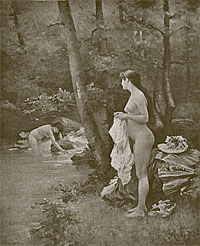
|
More elaborate in composition and material is "Chilly," by
Jules Scalbert: two modern wood-nymphs, one of whom already bathes in the pellucid waters
of a sylvan stream, while her companion lingers on the bank, half timid and half shivering
at the cold caress of the summer breeze. Scalbert, who has achieved an enviable reputation
as a painter of these graceful idylls, was born at the old city of Douai, in the
Department du Nord, and studied his art under Pils and Petit. He has been a regular
exhibitor at the Salon for some fifteen years. "Chilly" is one of his latest works.
|
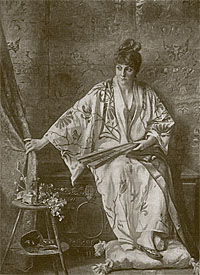
|
The name of Carl Sohn, the younger, is well and favorably known at the German
exhibitions. He belongs to a family of Dusseldorf artists, his father, after whom he is named
and whose pupil he is, being a distinguished portrait and genre painter. "At the Masquerade"
was one of the attractions of the Berlin Annual Exhibition of 1891.
|

|
One of the most successful graduates of the studios of Jacquand and J.L. Gerome,
Albert Aublet, is a Parisian by birth. He received his first
Salon medal in 1880, and won steadily increasing popularity, chiefly by pictures of a graceful
decorative character, remarkable for beauty of form and tender purity of color, of which
"Sleep" is an admirable example.
|

|
An appropriate pendant to "Sleep" is
"A Couch of Roses" by Joseph Saint-Germier,
another artist whose decorative pictures have gained him merited distinction. He is a native of
Toulouse, and after commencing his studies at the art academy of his native city, became a pupil in
Paris of the famous painter Galland, from whom his mastery of the style of subjects he adopted was
largely derived. Those who have had the good fortune to visit the New York mansion of the
late William H. Vanderbilt, now the home of his widow and of his younger son, Mr. George W. Vanderbilt,
and have examined the magnificent decorations of that American palace, will recall, among them, the
ceiling and wall paintings executed to order for the places they occupy by Galland, and form from them
that idea of the beauties of color in the pictures of his gifted disciple which our illustration cannot convey.
|
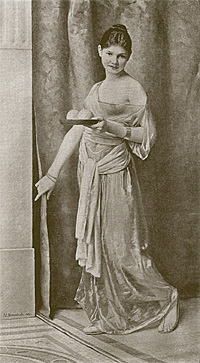
|
A painter of striking seductiveness of style is Max Nonnenbruch, of Munich.
After winning recognition by his earlier works of domestic genre, he devoted himself almost entirely
to idyllic and semi-classical subjects, akin in feeling to "The Favorite," in
which he found the true direction of his talent, and by which he is represented in the greatest
private collections of Germany.
|
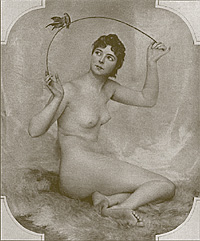
|
Paul Mousset is a Parisian artist,
a young man who while still a student achieved a distinct reputation
by his mastery of the figure. His pictures show him to be a strong and accurate draughtsman,
a good colorist, and a painter of elegant and finished execution. Although he produces portraits
and genre subjects, his best work has unquestionably been in the line of "The Love Birds,"
pictures painted for the decoration of some of the most luxurious mansions of Paris.
|
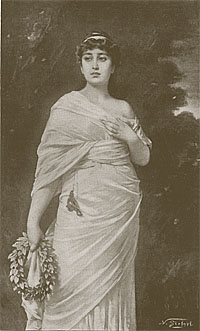
|
More
in the vein of Nonnenbruch, but of even more extended fame and popularity, is Nathaniel Sichel,
of Berlin, a graduate of the Berlin Academy and the Paris Academy. He was born at Mayence, and
was first a lithographer. He is a favorite portrait
painter in Germany, and his historical pictures may be found in various public collections, but
the world knows him best by his refined and dignified classical pictures, like "A Vestal Virgin,"
and his peculiarly beautiful ideal compositions.
|
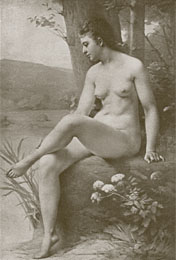
|
Emmanuel Benner is one of the foremost painters of the figure, and one of the greatest masters of the
nude in particular, who exhibit at the Paris Salon. He was born at Mulhausen, in Alsace, and studied
under Pils in Paris. His pictures, which,
like "A Study," are usually very simple in subject, possess an extraordinary naturalness
of color, and are equally lifelike in modeling and spirit.
|
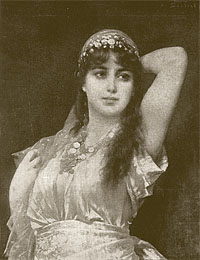
|
In "Turandot" N. Sichel gives us
one of his ideal Oriental types, whose voluptuous and alluring beauty is in marked contrast to
the serene dignity of his "Vestal Virgin."
|
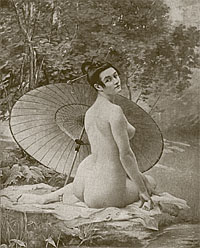
|
The "Japanese Bather" of P. Mousset is another picture
in the same feeling as "The Love Birds," but of more elaborate treatment. The original of this
bather is a native Japanese woman of a dazzling beauty very rare with her race, who came to
Europe some years ago, and has since served as a model for the Paris painters - the only Japanese model
known, at least outside of
Japan.
|

|
Gustav Graef of Berlin is a widely known painter, who has been especially successful
in female portraiture, and in those gentle and poetic ideal types of feminine beauty of
which his "Bianchina," which is an idealized portrait of a Venetian girl, is a sterling illustration.
|

|
Rene-Joseph Gilbert, who is one of the foremost of the pupils of the late Alexandre Cabanel,
was born in Paris, and is a thorough Parisian in his art. He is a
brilliant and powerful colorist, and his pictures reveal an amazing facility in the rendition of
textures, which, even in the black and white reproduction of "A Midsummer Siesta," can be distinctly
observed.
|

|
Another of the Paris artists, although only by adoption, is Miecislaw Reyzner. He is of
Polish origin, and studied at the Munich Academy and at the Paris Ecole des Beaux Arts. The success
he attained with pictures of the dainty, decorative order of his "Morning," encouraged him to settle
permanently in Paris, where he speedily found substantial support.
|
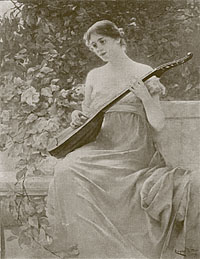
|
Caspar Ritter, of Carlsruhe, is a
favorite German painter of subjects of sentiment. His "Consolation in Song" is a realization of the
German version of our familiar English proverb, "Music Hath Charms."
|

|
At the Salon exhibition of 1891, a picture which attracted a marked amount of attention was a
vividly painted midsummer landscape, with the figures of three wood-nymphs, basking in the flood
of golden sunshine. It was entitled "Summertime." The painter was A. Axilette, a Parisian artist
whose studio was already well known to collectors. The success of "Summertime" in Europe was
enormous. It was successively exhibited at various continental exhibitions, and everywhere
repeated the hit it had made in France. It was, in fact, one of those works of which it is
said that they "make" their authors, and in the sense that it completely established the painter's
reputation, "Summertime" realized this figure of speech.
|
|
It will be noted, from these examples, that they conform closely to the title of this work. They
are essentially modern, in every quality of conception and execution. The great and celebrated
works of figure art of the first half of the present century, and those of the remoter past, are
familiar to all persons of cultivated tastes and a love for the beautiful. The immortal productions of Titian and
Correggio, of Giorgione, Raphael, Ribera, and the other masters of the great art revival of Italy,
are ripe with the ripeness of centuries. Their splendors have ceased to be mere matters of rare
artistic skill, and they have taken their places among the classics of art. So, too, each in
their degree, have the masterpieces of Rembrandt, Rubens, and Vandyck, in the Netherlands;
those of Watteau, Boucher, Poussin, Mignard, Lebrun in France; of Durer, Holbein, and the rest,
in Germany; and of the Spanish masters, at whose head stood Velasquez and Murillo. The same
world-wide recognition has been accorded to the productions of the early English school, over
which reigned the geniuses of Reynolds, Gainsborough, and Romney. Only less famous becasue they
are nearer our own day are the works of the painters of the art revolution in France, and of
those who, like Kaulbach and his contemporaries, re-created the art of Germany. It has remained
for "Modern Figure Painting" to do for the men of the end of the nineteenth century, what an
army of historians, biographers, and critics have done for their predecessors.
The art of the present, and especially that of the painter of the figure, is part of the life
of the present. The methods and inspirations of the artist have changed, just as our methods
of living have changed from those of our forefathers. The world progresses ceaselessly in all
things, and in none has its progress been more distinct and marked than in the arts. Literature,
music, sculpture, painting, have kept pace with the enormous strides in advance made by science
and invention. The end of the last century, the last twenty-five years of it, that is to say,
revolutionized the world. The American War of Independence created an epoch, and its results
completely changed the traditional conditions of the globe, for they have reached even into the
remotest strongholds of immemorial barbarism, and moulded nations out of what had been a chaos.
The same period of the nineteenth century will go into history with a similar record, and in the
credit for it art will bear its important share; and the share in it of the art of the modern
figure painter will not be the least.
|
|
|
|





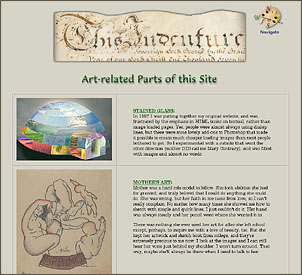



![]() Copyright © 2007, Mary S. Van Deusen
Copyright © 2007, Mary S. Van Deusen